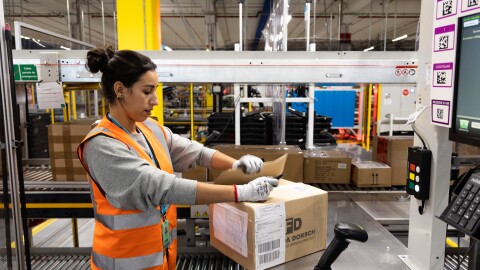Last year we celebrated our 20th anniversary in the UK, and we thought now would be a good moment to step back and reflect on what our overall economic contribution has been to the UK over that time. We’re sharing a snapshot of our job creation, tax contributions, and broader economic impact in the UK, including economic analysis that builds on our regular reporting cycle to go deeper than usual and provide a better understanding of our business and how we support the communities where we operate.
Our contribution to UK employment
Over just eight years, from 2010 to 2018, we’ve made direct investments in our UK operations of more than £18bn. This includes both capital expenditure (such as the infrastructure we build, such as our fulfilment centres, corporate offices and data centres), and operating expenditures (such as the salaries we pay to UK employees). The UK has now become one of our largest global hubs for talent, including our R&D operations in Cambridge, Edinburgh and London, our AWS data centres in London and our state-of-the-art fulfilment and distribution centres across the country.
As a result of our investments, Amazon has become a major UK employer. A large proportion of the jobs we’ve created are in parts of the UK—such as the North of England and the Midlands—with a history of high unemployment levels. As of the end of 2018, we directly employed more than 27,500 people in the UK, more than 20,000 of whom are based outside London and South-East England. In October 2018, we increased our rates of pay to ensure that everyone who works for us earns at least £9.50 to £10.50 an hour depending on location, which is comparable to the current UK Living Wage.
We recently announced that we’re adding another 2,000 new jobs to our workforce in 2019, bringing the total to over 29,500. These jobs include thousands of data scientists and technology experts who work at our Development Centres in Edinburgh – Amazon’s first Development Centre outside of the U.S., established 15 years ago; in Cambridge, where teams work on the global development of Amazon devices, Alexa, cloud storage with Amazon S3 and Prime Air; in London, one of our global development hubs for Prime Video; and at over 20 fulfilment centres in England, Scotland and Wales.
We also invest in training and development programmes. For example, in February 2019, we created a fully-funded apprenticeship programme that will provide opportunities for 1,000 new recruits and existing employees in 2019 and 2020, helping them to become future leaders and innovators. Apprentices will work across the UK at our corporate sites, operations sites, and Development Centres, with degree apprenticeships paying up to £30,000 a year. We also offer a range of upskilling programmes for all of our employees, whether they work in a corporate office, a fulfilment centre, a development centre or a data centre. Just this year, we were named #1 in LinkedIn's Top Companies UK poll. If you’re interested in learning more, we encourage you to visit our facilities. Since 2015, we have offered public tours of many of our UK fulfilment centres, enabling people across the UK to learn more about what we do.
In addition to our direct job creation, our investment indirectly supports a large number of jobs in our UK supply chain and across the network of sellers who have used our technology and services to grow their businesses through increased sales within, and beyond, the UK. Capital Economics, an independent macroeconomic research consultancy, estimates that companies in Amazon’s supply chain (including, for example, in building services, property services and professional services) supported 122,500 additional jobs in the UK in 2018. Of these, the largest proportion are in the North of England and the Midlands. Amazon economic research also indicates that small businesses and entrepreneurs using the tools and services we build to help them grow—from selling on Amazon to Fulfilment By Amazon (FBA)—supported more than 90,000 jobs in the UK in 2018.
If you combine our direct employment with these indirect employment effects, this means that Amazon enables employment for more than 240,000 people across the UK.
Our tax contributions in the UK
As we continue to hire and grow in the UK, we help fund public services and infrastructure throughout the country. We do this through the taxes that are collected by the Exchequer as a consequence of our activities in the UK. Those taxes fall into two categories:
- Directly incurred taxes: the taxes that are directly incurred and payable by Amazon, including Employer National Insurance, business rates, Corporation Tax, import duties, and Stamp Duty Land Tax; and
- Indirect taxes collected: the taxes we collect and remit from our customers, employees, and other third parties because of our business activities in the UK. These include VAT and the taxes paid by our employees through PAYE.
It’s important to understand both of those categories, because focusing narrowly on one aspect of taxation, such as Corporation Tax – which according to the Institute of Fiscal Studies accounts for only around 6% of total taxes collected from UK businesses and individual taxpayers – doesn’t tell the whole story. This is one of the reasons why PwC produces a total tax contribution study for The 100 Group (an organisation which represents the Finance Directors of the UK’s largest companies, including many FTSE 100 firms). The study highlights that, of the receipts paid over by these companies to the UK Government, over two thirds are indirect taxes (such as payroll taxes and VAT), while around one third are directly incurred taxes.
This is particularly relevant for growing businesses like Amazon which have a high volume of sales, but where operating profits remain relatively low due to price pressure in competitive markets, intense capital investment programmes, and increasing operating costs (including those from a growing workforce). Most governments —including the UK Government—actively encourage companies to make these investments, and they often use the taxation system to do so. Capital allowances and R&D credits are designed to stimulate the kind of investment necessary to grow the economy and create jobs. On the one hand, these reduce Corporation Tax, but this is more than made up for by the increased tax revenue or lower costs for the Government in other areas.
So what has Amazon recorded as its UK investments, directly incurred tax charge and indirect taxes collected for 2018?
- In 2018, the total revenues of Amazon’s activities in the UK were £10.89bn ($14.524bn)
- We invested more than £625m in our infrastructure
- Our total directly incurred taxes were £220m. Employer taxes accounted for the largest proportion of these, followed by business rates, Corporation Tax, then other taxes such as Stamp Duty Land Tax
- The indirect taxes we collected were an additional £573m as a result of our business activities in the UK
- Our total tax contribution (combining direct and indirect) was therefore £793m
In addition, we also assist third-party sellers with the collection and payment of VAT in the UK. To put this in a global context, sales by our selling partners — who are mostly small and medium-sized businesses – in Amazon stores worldwide accounted for 58% of Amazon’s total global physical gross merchandise sales in 2018. In the UK, we estimate that the Government has collected more than £1bn in VAT receipts from the proportion of UK sales in Amazon stores that are subject to UK VAT. We haven’t included those numbers in our indirect tax figure above since these are taxes paid by third parties to HMRC. Amazon was the first signatory to the government’s voluntary cooperation agreement to drive HMRC collection of these taxes owed, and we’ve also introduced low-cost and simple tools for third-party sellers to register, report, and remit VAT.
Our contribution to UK exports, innovation and business growth
In addition to our direct investment, job creation and tax contributions, our business provides opportunities for thousands of small business owners across the UK, in both rural and urban locations, to become global sellers through the training, tools and services we invent for entrepreneurs.
There are now tens of thousands of UK-based small and medium-sized enterprises (SMEs) who sell their products in Amazon’s UK store and also now reach national and international customers. They achieved total export sales of more than £2bn in 2018. Many of these businesses are based outside of London and other large UK cities. The largest proportion of our UK-based selling partners by volume of sales (44%), are sellers located in the North of England and the Midlands. Many are in rural or semi-urban locations.
Amazon Web Services is also helping UK business growth. We now have more than 100,000 UK customers using AWS cloud technologies to manage their workloads, innovate, and grow their businesses. Public sector and government departments frequently say they have seen a 40% to 60% cost saving when they use AWS, and many UK enterprise businesses and FTSE 100 listed companies say they get greater reliability with AWS, which is why they rely on our technology for their mission-critical applications. Many UK start-ups and SMEs also run their businesses on AWS, often saying it saves them money and simplifies processes. They are able to pay for what they use and don’t need to buy their own server hardware. Many more people are taking advantage of our training and certification programs, as well as other upskilling initiatives such as AWS Academy, AWS Educate, AWS Get IT and AWS re/start. AWS re/start trains people with no previous technical knowledge to get a job in the IT industry, working with AWS, one of our customers or AWS Partner Network Partners.
The UK is a hotbed of talent and opportunity, and we’re pleased to play a role in nourishing that and supporting growth. Twenty years since our UK launch, we continue to be excited by the potential to continue to invest, invent, and create jobs and income in communities across the country.












